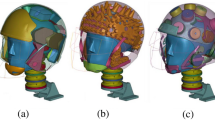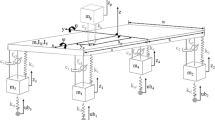Abstract
Neck injuries frequently seen in low-speed rear-end collisions are referred to as whiplash injuries. Most of the proposed anti-whiplash systems in the literature rely on reducing the backset. A relatively new and promising alternative concept is a slideable seat. This study aimed to parametrically analyze an anti-whiplash vehicle seat that can slide backward against a horizontal suspension arrangement composed of a spring and a damper in response to a rear-end collision, and to investigate the effects of the suspension parameters on the injury risk. A simplified model of a slideable vehicle seat is developed, and simulations are conducted in LS-DYNA® environment using this slideable seat model and the commercially available finite element model of the BioRID II dummy. The maximum value of the Neck Injury Criterion (NICmax) is used as the measure of the injury risk. As a result, a strong linear inverse correlation is observed between NICmax and the maximum seat sliding distance, while the stiffness and damping coefficients of the suspension are varied. This result is also verified by obtaining the same NICmax value for the same maximum seat sliding distance (although the stiffness and damping coefficients are different). It is also shown that, for a given backset value as large as 60 mm, a slideable seat with the suspension parameters selected to yield a reasonable maximum seat sliding distance such as 100 mm significantly improves NICmax compared to a standard seat. As the maximum seat sliding distance is increased, the injury risk becomes smaller.









Similar content being viewed by others
Abbreviations
- \(a_{\text{head}} (t)\) :
-
Horizontal acceleration of the center of gravity of the head
- \(a_{T1} (t)\) :
-
Horizontal acceleration of the first thoracic vertebrae
- b :
-
Backset distance
- c :
-
Damping coefficient of the anti-whiplash seat suspension damper
- d :
-
Maximum sliding distance of the seat
- F b :
-
Initial bias force of the anti-whiplash seat suspension spring
- k :
-
Stiffness of the anti-whiplash seat suspension spring
- NIC:
-
Neck Injury Criterion
- t :
-
Time
- x :
-
Amount of the initial compression given to the anti-whiplash seat suspension spring
References
Eck JC, Hodges SD, Humphreys SC (2001) Whiplash: a review of a commonly misunderstood injury. Am J Med 110(8):651–656
Sterner Y, Gerdle B (2004) Acute and chronic whiplash disorders—a review. J Rehabil Med 36(5):193–210
Davis CG (2013) Mechanisms of chronic pain from whiplash injury. J Forensic Leg Med 20(2):74–85
Svensson MY, Lövsund P, Håland Y, Larsson S (1996) The influence of seat-back and head-restraint properties on the head-neck motion during rear-impact. Accid Anal Prev 28(2):221–227
Siegmund GP, Heinrichs BE, Wheeler JB (1999) The influence of head restraint and occupant factors on peak head/neck kinematics in low-speed rear-end collisions. Accid Anal Prev 31(4):393–407
Chapline JF, Ferguson SA, Lillis RP, Lund AK, Williams AF (2000) Neck pain and head restraint position relative to the driver’s head in rear-end collisions. Accid Anal Prev 32(2):287–297
Watanabe Y, Ichikawa H, Kayama O, Ono K, Kaneoka K, Inami S (2000) Influence of seat characteristics on occupant motion in low-speed rear impacts. Accid Anal Prev 32(2):243–250
Golinski WZ, Gentle CR (2001) Biomechanical simulation of whiplash—some implications for seat design. Int J Crashworthiness 6(4):573–584
Farmer CM, Wells JK, Lund AK (2003) Effects of head restraint and seat redesign on neck injury risk in rear-end crashes. Traffic Inj Prev 4(2):83–90
Szabo TJ, Voss DP, Welcher JB (2003) Influence of seat foam and geometrical properties on BioRID P3 kinematic response to rear impacts. Traffic Inj Prev 4(4):315–323
Eriksson L (2005) Influence of head restraint position on long-term AIS 1 neck injury risk. Int J Crashworthiness 10(6):545–555
Sendur P, Thibodeau R, Burge J, Tencer A (2005) Parametric analysis of vehicle design influence on the four phases of whiplash motion. Traffic Inj Prev 6(3):258–266
Stemper BD, Yoganandan N, Pintar FA (2006) Effect of head restraint backset on head-neck kinematics in whiplash. Accid Anal Prev 38(2):317–323
Viano DC (2008) Seat design principles to reduce neck injuries in rear impacts. Traffic Inj Prev 9(6):552–560
Ivancic PC, Sha D, Panjabi MM (2009) Whiplash injury prevention with active head restraint. Clin Biomech 24(9):699–707
Shin MK, Park KJ, Park GJ (2003) Occupant analysis and seat design to reduce neck injury from rear end impact. Int J Crashworthiness 8(6):573–581
Lee J-W, Yoon K-H, Park G-J (2003) A study on occupant neck injury in rear end collisions. Proc Inst Mech Eng D J Automob Eng 217(1):23–29
Viano DC (2003) Seat properties affecting neck responses in rear crashes: a reason why whiplash has increased. Traffic Inj Prev 4(3):214–227
Viano DC (2003) Influence of seat properties on occupant dynamics in severe rear crashes. Traffic Inj Prev 4(4):324–336
Kumar S, Ferrari R, Narayan Y, Vieira ER (2004) The effect of occupant position in volunteers subjected to whiplash-type rear impacts. Int J Crashworthiness 9(6):599–606
Latchford J, Chirwa EC, Chen T, Mao M (2005) The relationship of seat backrest angle and neck injury in low-velocity rear impacts. Proc Inst Mech Eng D J Automob Eng 219(11):1293–1302
Bring G, Björnstig U, Westman G (1996) Gender patterns in minor head and neck injuries: an analysis of casualty register data. Accid Anal Prev 28(3):359–369
Viano DC (2003) Seat influences on female neck responses in rear crashes: a reason why women have higher whiplash rates. Traffic Inj Prev 4(3):228–239
Hong SJ, Choi HY (2009) Effects of head restraint and vehicle damage severity on neck injury risk. Int J Automot Technol 10(3):347–353
Carlsson A, Siegmund GP, Linder A, Svensson MY (2012) Motion of the head and neck of female and male volunteers in rear impact car-to-car impacts. Traffic Inj Prev 13(4):378–387
McCreesh K, Arthurs S, Horgan S, Keane L, Meagher L (2012) Vehicle head restraint positioning knowledge and behaviours in a sample of Irish drivers. Int J Inj Contr Saf Promot 19(4):340–346
Farmer CM, Wells JK, Werner JV (1999) Relationship of head restraint positioning to driver neck injury in rear-end crashes. Accid Anal Prev 31(6):719–728
Kumar S, Narayan Y, Amell T (2000) Role of awareness in head-neck acceleration in low velocity rear-end impacts. Accid Anal Prev 32(2):233–241
Latchford J, Chirwa EC (2000) Airbag head restraint system. Proc Inst Mech Eng D J Automob Eng 214(3):229–241
Schmitt K-U, Muser MH, Niederer PF (2003) Evaluation of a new visco-elastic foam for automotive applications. Int J Crashworthiness 8(2):169–177
Krafft M, Kullgren A, Ydenius A, Tingvall C (2002) Influence of crash pulse characteristics on whiplash associated disorders in rear impacts–crash recording in real life crashes. Traffic Inj Prev 3(2):141–149
Panjabi MM, Cholewicki J, Nibu K, Grauer JN, Babat LB, Dvorak J (1998) Mechanism of whiplash injury. Clin Biomech 13(4–5):239–249
Yoganandan N, Pintar FA, Gennarelli TA (2002) Biomechanical mechanisms of whiplash injury. Traffic Inj Prev 3(2):98–104
Chen HB, Yang KH, Wang ZG (2009) Biomechanics of whiplash injury. Chin J Traumatol 12(5):305–314
Fice JB, Cronin DS (2012) Investigation of whiplash injuries in the upper cervical spine using a detailed neck model. J Biomech 45(6):1098–1102
Schmitt K-U, Muser M, Heggendorn M, Niederer P, Walz F (2003) Development of a damping seat slide to reduce whiplash injury. Proc Inst Mech Eng D J Automob Eng 217(11):949–955
Luo M, Zhou Q (2010) A vehicle seat design concept for reducing whiplash injury risk in low speed rear impact. Int J Crashworthiness 15(3):293–311
Himmetoglu S, Acar M, Bouazza-Marouf K, Taylor AJ (2008) Energy-absorbing car seat designs for reducing whiplash. Traffic Inj Prev 9(6):583–591
Himmetoglu S, Acar M, Taylor AJ, Bouazza-Marouf K (2007) A multi-body head-and-neck model for simulation of rear impact in cars. Proc Inst Mech Eng D J Automob Eng 221(5):527–541
Deter T, Malczyk A, Kuehn M (2007) Validation of a seat-dummy simulation model for rear-impact. Paper presented at: 20th international technical conference on the enhanced safety of vehicles conference (ESV); June 18–21, 2007; Lyon, France
Stahlschmitd S, Keding B, Franz U, Hirth A (2006) BioRID II dummy model development—influence of parameters in validation and consumer tests. Paper presented at: 9th international LS-DYNA conference; June 04–06, 2006; Dearborn, Michigan, USA
Stahlschmitd S, Keding B, Witowski K, Müllerschön H, Franz U (2006) BioRID II dummy model development—stochastic investigations. Paper presented at: 5th LS-DYNA forum; October 12–13, 2006; Ulm, Germany
Özdemir M, İder SK, Gökler Mİ, Dicle H, Anık E, İnce MS (2010) “BioRID II” ve basitleştirilmiş koltuk modelleri ile “whiplash” analizi (in Turkish). Paper presented at: 5th automotive technologies congress (OTEKON 2010); June 07–08, 2010; Bursa, Turkey
Özdemir M (2013) Analysis of whiplash during rear crash and development of an anti-whiplash seat mechanism. Ph.D. Thesis, Middle East Technical University, Ankara, Turkey
Boström O, Fredriksson R, Håland Y, Jakobsson L, Krafft M, Lövsund P, Muser MH, Svensson MY (2000) Comparison of car seats in low speed rear-end impacts using the BioRID dummy and the new neck injury criterion (NIC). Accid Anal Prev 32(2):321–328
European New Car Assessment Programme (Euro NCAP) (2008) The dynamic assessment of car seats for neck injury protection testing protocol. Version 2.8
Yuen M, Bilston LE (2004) Development of an anti-whiplash seat. A research and analysis report performed by the Prince of Wales Medical Research Institute, sponsored by/available from the Australian Transport Safety Bureau (ATSB)
Golinski WZ, Gentle R (2005) The influence of seat back rake on ligament loadings in rear-end impact. Proc Inst Mech Eng D J Automob Eng 219(2):197–205
European New Car Assessment Program (Euro NCAP) (2013) Assessment protocol—adult occupant protection. Version 5.5
Acknowledgments
The authors would like to thank Hüseyin Dicle, Evren Anık, and Murat Sefa İnce, at the Seat Design Management of TOFAŞ R&D Directorate, for their valuable discussions. Additionally, Mustafa Özdemir is thankful to the Scientific and Technological Research Council of Turkey (TÜBİTAK) for the support provided through the National Scholarship Programme for PhD students. Last but not least, thanks to the METU-BILTIR Center Vehicle Safety Unit for the facilities provided.
Author information
Authors and Affiliations
Corresponding author
Additional information
Technical Editor: Fernando Antonio Forcellini.
Rights and permissions
About this article
Cite this article
Özdemir, M., İder, S.K. & Gökler, M.İ. Parametric analysis of an anti-whiplash system composed of a seat suspension arrangement. J Braz. Soc. Mech. Sci. Eng. 37, 777–784 (2015). https://doi.org/10.1007/s40430-014-0192-5
Received:
Accepted:
Published:
Issue Date:
DOI: https://doi.org/10.1007/s40430-014-0192-5




